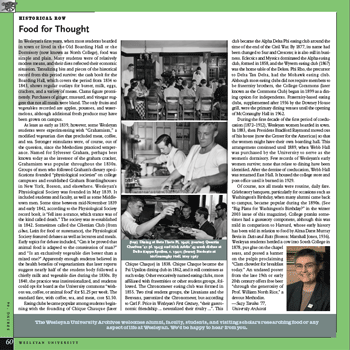HISTORICAL ROW: FOOD FOR THOUGHT
 In Wesleyan’s first years, when most students boarded in town or lived in the Old Boarding Hall or the Dormitory (now known as North College), food was simple and plain. Many students were of relatively modest means, and their diets reflected their economic situation. Tantalizing bits and pieces of the historical record from this period survive: the cash book for the Boarding Hall, which covers the period from 1834 to 1843, shows regular outlays for butter, milk, eggs, crackers, and a variety of meats. Clams figure prominently. Purchases of ginger, mustard, and vinegar suggest that not all meals were bland. The only fruits and vegetables recorded are apples, potatoes, and watermelons, although additional fresh produce may have been grown on campus.
In Wesleyan’s first years, when most students boarded in town or lived in the Old Boarding Hall or the Dormitory (now known as North College), food was simple and plain. Many students were of relatively modest means, and their diets reflected their economic situation. Tantalizing bits and pieces of the historical record from this period survive: the cash book for the Boarding Hall, which covers the period from 1834 to 1843, shows regular outlays for butter, milk, eggs, crackers, and a variety of meats. Clams figure prominently. Purchases of ginger, mustard, and vinegar suggest that not all meals were bland. The only fruits and vegetables recorded are apples, potatoes, and watermelons, although additional fresh produce may have been grown on campus.
At least as early as 1839, however, some Wesleyan students were experimenting with “Grahamism,” a modified vegetarian diet that precluded meat, coffee, and tea. Stronger stimulants were, of course, out of the question, since the Methodists practiced temperance. Named for Sylvester Graham, perhaps best known today as the inventor of the graham cracker, Grahamism was popular throughout the 1830s. Groups of men who followed Graham’s dietary specifications founded “physiological societies” on college campuses and established Graham Boardinghouses in New York, Boston, and elsewhere. Wesleyan’s Physiological Society was founded in May 1839. It included students and faculty, as well as some Middletown men. Some time between mid-November 1839 and early 1842, according to the Physiological Society record book, it “fell into a trance, which trance was of the kind called death.” The society was re-established in 1842. Sometimes called the Cibenian Club (from cibus, Latin for food or sustenance), the Physiological Society featured debates as well as lectures and meals. Early topics for debate included, “Can it be proved that animal food is adapted to the constitution of man?” and “Is an exclusively vegetable diet better than a mixed one?” Apparently enough students believed in the health benefits of vegetarianism that later reports suggest nearly half of the student body followed a chiefly milk and vegetable diet during the 1830s. By 1840, the practice was institutionalized, and students could opt for board at the University commons “without tea, coffee, or animal food” for $1.25 per week. The standard fare, with coffee, tea, and meat, cost $1.50.
Eating clubs became popular among students beginning with the founding of Chique Chauque (later Chique Chaque) in 1838. Chique Chaque became the Psi Upsilon dining club in 1862, and it still continues as such today. Other evocatively named eating clubs, most affiliated with fraternities or other student groups, followed. The Chronometer eating club was formed in 1855. Two rival student groups, the Livanians and the Betreans, patronized the Chronometer, but according to Carl F. Price in Wesleyan’s First Century, “their gastronomic friendship … neutralized their rivalry …”. This club became the Alpha Delta Phi eating club around the time of the end of the Civil War. By 1877, its name had been changed to Star and Crescent; it is also still in business. Eclectics and Mystics dominated the Alpha eating club, formed in 1858, and the Wyvern eating club (1867) was the home table of the Dekes. Phi Rho, the precursor to Delta Tau Delta, had the Mohawk eating club. Although most eating clubs did not require members to be fraternity brothers, the College Commons (later known as the Commons Club) began in 1899 as a dining option for independents. Fraternity-based eating clubs, supplemented after 1936 by the Downey House grill, were the primary dining venues until the opening of McConaughy Hall in 1962.
During the first decade of the first period of coeducation (1872–1912), Wesleyan women boarded in town. In 1883, then President Bradford Raymond moved out of his house (now the Center for the Americas) so that the women might have their own boarding hall. This arrangement continued until 1889, when Webb Hall was purchased by the University to serve as the women’s dormitory. Few records of Wesleyan’s early women survive; none that relate to dining have been identified. After the demise of coeducation, Webb Hall was renamed East Hall. It housed the college store and post office until it burned in 1929.
Of course, not all meals were routine, daily fare. Celebratory banquets, particularly for occasions such as Washington’s Birthday, when many alumni came back to campus, became popular during the 1890s. (See “Big Plans for Washington’s Birthday?” in the winter 2003 issue of this magazine). College pranks sometimes had a gustatory component, although this was mild in comparison to Harvard, whose early history has been told in relation to food by Alma Darst Murray Bevis in Diets and Riots (Boston: Marshall Jones, 1936). Wesleyan students herded a cow into South College in 1878, put glue on the chapel seats, and posted a banner on the pulpit proclaiming “Clam chowder for breakfast today.” An undated poster from the late 19th or early 20th century offers free beer “through the generosity of Prof. William North Rice,” a devout Methodist.
